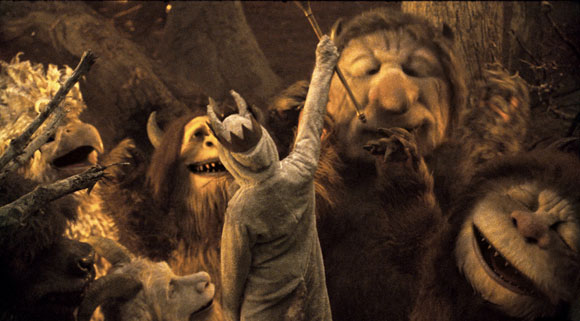Where the Wild Things Are

Bereft of creativity, it would seem the hipsters have returned to rape the childhood of every generation before them. Maurice Sendak gladly sold out to these vessels of mediocrity, standing idly by in approval while Spike Jonze—the poster-child filmmaker of of this image-conscious “sub”-culture (if it can be said to be a culture at all)—slapped together a series of incomprehensible, unrelated dialogues in a depressing world with narcissistic, crass monsters who happen to look just like the ones in Mr. Sendak’s book.
“I like the way you destroy stuff. There’s a spark to your work that can’t be taught,” observes Carol (James Gandolfini), the insouciant, horned beast who befriends Max (Max Records), the protagonist of Maurice Sendak’s 1963 classic upon which this film is based. Is Carol talking to Max, or to the director who destroyed this film?
Familiar to at least a couple generations who read Mr. Sendak’s book, the story begins as the belligerent Max lashes out at his mother. He runs away, takes a boat an island where he finds a group of monsters upset at the ruckus the irritable, depressed Carol (James Gandolfini) has made. We don’t know how or why Carol snapped. When Max is cornered by them, he belts out, “Be still!”
In his woolly wolf costume, he fabricates a story of Viking origins and magical powers. Awestruck and in desperate need of guidance, the beasts crown him king. Why are these walking shag carpets without an alpha? Despite their self-awareness, cognitive skills, and language, these seem to be the only animals in the world incapable of identifying at least one leader among them. There’s only a hint that Carol is too distraught over some unresolved relationship issues to head the pack. What follows is a total collapse of coherent storytelling—disconnected scenes of running, jumping, throwing, thrashing, and destroying interspersed with languid stretches of navel gazing (read: moping).
Alexander (Paul Dano), the irascible goat, and Douglas (Chris Cooper) the laconic bird provide us with moments of well-timed wit. K.W. (Lauren Ambrose) translates into entire thoughts the solitary hoots of two daffy-looking owls regarded as sages, though it’s intimated nobody has any idea what they’re saying. The gang—including Michael Berry, Jr. as the quiet Bull and the talented Catherine O’Hara as the brooding Judith—is largely self-absorbed, save for Ira (Forest Whitaker). What child wants to be around bitchy, manic-depressive monsters?
Spike Jonze’s previous collaborations with screenwriter Charlie Kaufman (Adaptation, Being John Malkovich) coupled fantastic imagery and narrative. This is his freshman stab at writing a feature-length motion picture with the help of counterculture author Dave Eggers. Mr. Jonze envisions the furry beasts as embodiments of Max’s recalcitrant emotions, but to what end? In an HBO “First Look” feature this week, the director argues the film is not meant for children. Instead, he says, it’s about childhood as interpreted by adults. That doesn’t wash.
No dialogues or actions connect from scene to scene. No character development takes place, save perhaps the rekindling of K.W. and Carol’s friendship—the genesis and nature of which is left unexplained. No groundwork is laid to make you care about the characters, of Max’s imagination, who carry conversations ostensibly adult in tone, perspective and scope—inaccessible to the inexperienced mind of a child. If the beginning with mom (Catherine Keener) and her boyfriend (Mark Ruffalo) is meant to set up a thesis of parental neglect, the unsatisfying conclusion doesn’t bookend it properly. Spike Jonze and Dave Eggers as screenwriters aren’t exonerated from the duty to adapt Mr. Sendak’s book into a full-length feature with a complete, cogent narrative that progresses from beginning to end.
Additionally, the cinematography is catastrophic. Shaky, hand-held camera work is overused to exhaustion, as if we’re in a war film. The beauty of Mr. Sendak’s book was that one could quietly revel in the illustrations’ varied textures and colors. Here, close-ups zig, zag and jitter so much that one wonders if the next edition of the book will come equipped with a vibrating motor inside. As artistic are his purported intentions, Mr. Jonze’s imagination swims in banality—shot after nauseating shot of sunlight gleaming through treetops; drab palettes of brown, tan and bone-dry wood in contrast to the book’s lush environments. Earlier this year, District 9 was filmed for $30 million and looked as if it cost $150 million. This film cost $80 million and looks like $8000. Big-name actors’ salaries and endless retakes may have contributed to the mind-boggling production costs. It’s a huge investment, the returns of which aren’t passed on to the viewer.
Mr. Jonze and Mr. Eggers ultimately fail to understand their audience. Thirty-somethings like myself aren’t clamoring for endless loops of manufactured whimsy, indistinguishable from one scene to the next. We crave adventure, transporting us to exotic locations on suspenseful quests. Give me Terry Gilliam’s Time Bandits, or The Adventures of Baron Munchausen! So many dirt fights and inexplicable smash-fests overshadow the deeper issue of Max’s discontent that I simply do not buy the esoteric purpose alleged by Mr. Jonze and Mr. Eggers. There are simple parallels drawn with Max’s home life—e.g. the fight with his sister—but the more aimless abstractions convolute basic psychological concepts to meaningless degree. I defer to the wisdom of Roger Ebert, whose First Rule of Symbolism states, “If you have to ask what it symbolizes, it didn’t.”
 Where The Wild Things Are • Dolby® Digital surround sound in select theatres • Aspect Ratio: 2.39:1 • Running Time: 94 minutes • MPAA Rating: PG for mild thematic elements, some adventure action and brief language. • Distributed by Warner Bros. Pictures
Where The Wild Things Are • Dolby® Digital surround sound in select theatres • Aspect Ratio: 2.39:1 • Running Time: 94 minutes • MPAA Rating: PG for mild thematic elements, some adventure action and brief language. • Distributed by Warner Bros. Pictures